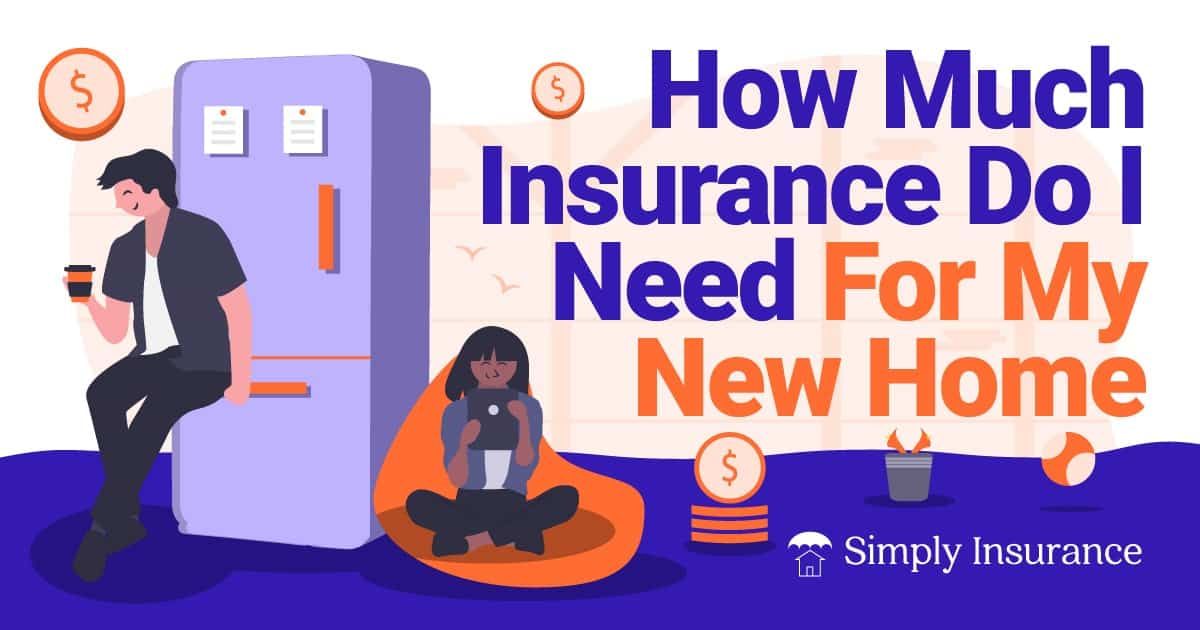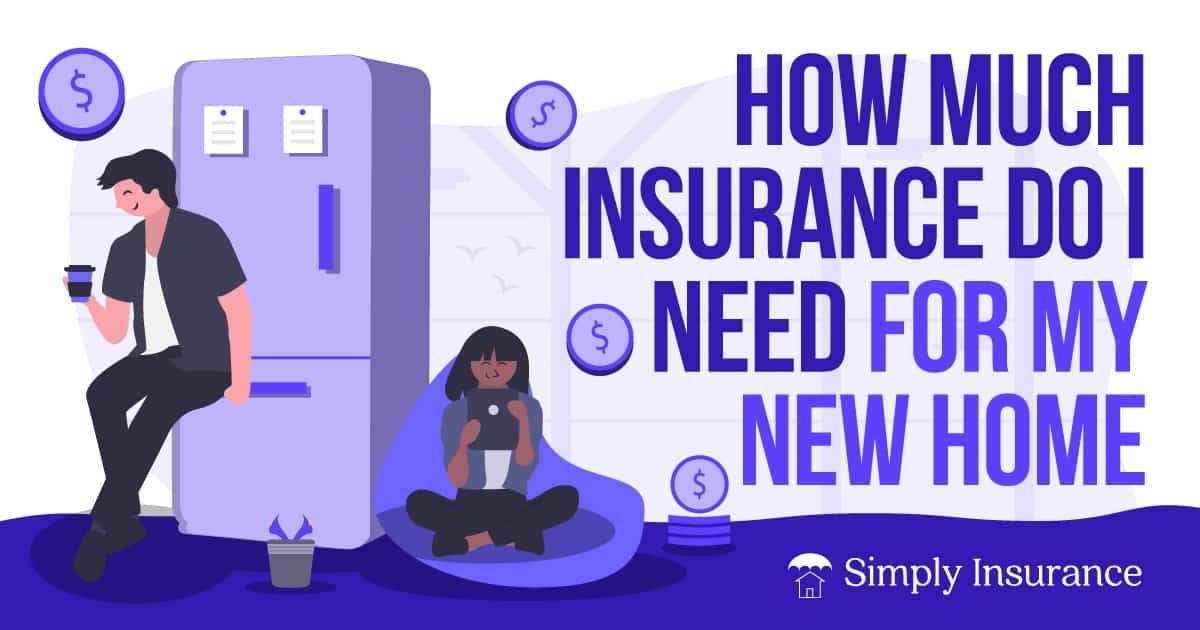Few moments are as exciting as getting your home insurance and signing the closing papers on a new home.
Whether it’s your first home, or the place you plan to spend your golden years, grasping those keys feels fantastic.

But before you get to that moment, you have a lot to work out.
There’s the financing, the down payment, the moving truck, the sale of your previous home (if it’s not your first), and, of course, the cost of your homeowners insurance.
Unlike auto insurance, there is no law that says you have to carry home insurance.
Your mortgage company, however, will insist on protecting their investment. And you of course have a huge investment to protect as well.
So how much insurance do you really need for your new home? Let’s break it down.
Understanding Replacement Cost
When you buy a house, you’re purchasing both the land and the structure (your house) that are present there.
While home insurance provides a wide array of protection from various risks, the main part of the policy is the dwelling coverage, which is the replacement cost of the home.
Replacement cost does not include the value of your land, the value of any additional structures (that’s covered in a separate part of the policy), nor the value of any personal property. It only covers the home itself.
Replacement cost is exactly what it sounds like.
It’s the amount that would be required to rebuild and replace your home if it were to be completely destroyed.
Replacement cost is not the same as market value, which confuses a lot of homeowners.
Replacement Cost Vs. Market Value
So what’s the difference between replacement cost and market value?
The market value of your home includes the land, the home, and other structures.
It can be impacted by a variety of factors that aren’t related to how much it would cost to rebuild your home.
You could take the exact same home, with all of the same details of construction, and place it in two different cities, and that home’s market value would be different in both locations.
That’s because market value is affected by location, supply and demand, the size and layout of the property, and other factors.
Replacement cost, on the other hand, is affected mainly by the cost of materials and labor to rebuild a house.
So replacement cost and market value can be vastly different.
It might cost more to rebuild your home than what you paid for that home.
It also might cost less. But either way, it’s the amount you actually need to cover your home properly.
Insurance companies cover houses based on their replacement cost since, even if your house burned to the ground, you would still have the land, and it would still have value.
THE SIMPLY INSURANCE WAY
Home Insurance made easy.
Agents not required.
Get quotes and sign up online without talking to an agent. But, we are here if you need us.
Unbiased, expert advice.
Get unbiased insurance education from licensed experts and also avoid dodgy sales calls.
Coverage in minutes.
You can get home insurance coverage within minutes of getting your quotes and applying.
How Replacement Cost Is Calculated
As you’re comparing insurance policies, you’ll notice something interesting.
Each insurance company comes up with a different replacement cost value. This is due to differences in their calculation systems.
It can also depend on the information they’ve received regarding the details of the home’s construction.
So how do you know which is right?
The more detail you provide regarding the home, the more accurate the replacement cost calculation will be.
Some of the details used in the calculation are the square footage, construction type, number of rooms, number of bathrooms, flooring type, countertop materials, decks and porches, and the type of roof and siding.
Since the cost of construction materials can fluctuate over time, the replacement cost of a home can fluctuate as well.
As a general rule, the cost to rebuild a home goes up over time with inflation.
So an older home can cost a lot more to rebuild than its depreciated value, especially since everything will need to be brought up to current codes.
Improperly calculated replacement costs can leave you underinsured.
There are several replacement cost calculators online that you can use to come up with your own number to compare to the insurance companies’ calculations.
HMFacts offers a detailed calculation for a reasonable price.
You can also discuss the amount of coverage needed with your mortgage company to find out how they are valuing the house.
Replacement Cost Vs. Actual Cash Value
Most insurance companies will be willing to insure your house for a replacement cost value that’s higher than what they have calculated at your request.
What they won’t do, however, is insure it at below replacement cost (and you shouldn’t want them to, nor would your mortgage company be happy about that).
There’s one exception to that rule. Some insurance policies won’t cover a home for replacement cost at all.
These are known as Actual Cash Value policies, and they only provide coverage for the depreciated value of that home.
This type of policy is usually only written for a home that doesn’t qualify for a standard policy, usually due to factors like age and condition. In most cases, replacement cost applies.
Even in a brand-new, just-built home, the actual cash value can quickly fall behind the replacement cost. It’s not the kind of coverage you want to protect your new home.
Extended Replacement Cost Coverage
So you’ve calculated a number for replacement cost, but you’re wondering what happens if there’s a total loss and it turns out that amount wasn’t enough after all.
That’s a very real possibility since things can change in between the start of the policy and the time of the claim.
Insurance companies combat this risk by offering extended replacement cost coverage. This is usually written as a percentage of the replacement cost value.
So a home insured for 125% of replacement cost is insured for the actual calculated cost plus 25% of that amount.
As an easy example, a policy with a 125% replacement cost on a home with a replacement cost calculated at $100,000 is $125,000.
That extra $25,000 can make up for increases in the price of lumber, for example, or new building codes that cost more to meet.
Some companies also offer guaranteed replacement cost.
This type of coverage guarantees that the policy will pay out the amount needed to rebuild the home regardless of how much it exceeds the calculated coverage.
So How Much Coverage Do You Need?
We’ve just spent quite a bit of time talking about replacement cost.
Mainly because it’s the benchmark for how much coverage you need to protect your house and the answer to your question.
And the truth is that:

Your mortgage company will have a requirement for how much coverage they expect you to carry on your policy.
Bottom line, you need a policy that will cover your home for the cost to replace it.
But beyond that, you also need a policy that protects you from increases in that cost.
Look for companies that offer either extended or guaranteed replacement cost coverage to make sure you’ll be covered if you need it.
INSURANCE WHERE YOU LIVE
Home insurance by state.
What About The Other Coverage?
As we discussed, the dwelling coverage is the biggest part of your policy, but there is a lot more on your insurance policy.
The other main portions of your policy are coverage for other structures (detached garages, sheds, etc.), personal property, liability, and loss of use.
As a general rule, insurance companies calculate other structures and personal property coverage as a percentage of the dwelling coverage.
If the other structure’s coverage is 10 percent of the dwelling coverage, that would come to $10,000 in the example of a $100,000 replacement cost policy above.
Both of these coverages can be increased to meet your needs.
Bear in mind that personal property coverage always comes with special limits on specific types of high-value items like jewelry, musical instruments, and art.
You may need to add riders designed to specifically protect any individual items with a value above the included limit.
Liability coverage is usually offered at a standard amount that, depending on the insurance company, may start as low as $100,000. This amount can also be increased at your request.
Taking Action
Finally, loss of use is coverage that pays living expenses during a covered claim where your home is uninhabitable for a time.
This coverage depends on the company and isn’t usually related to the dwelling coverage amount.
As long as your dwelling coverage is calculated correctly, most of the other coverage should fall in line. If you are ready to get covered you can click here to get an instant quote and coverage.
